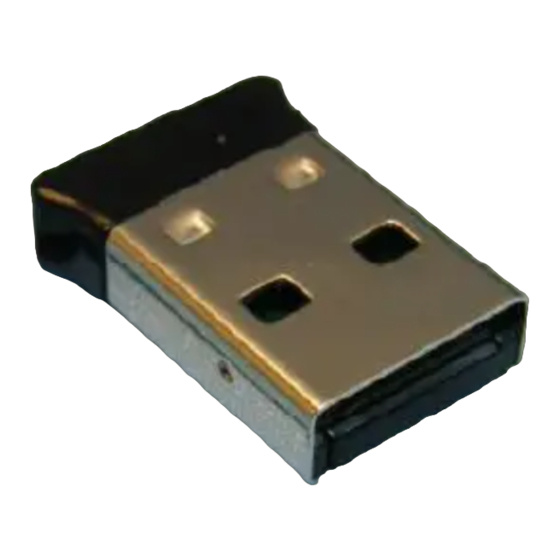
Advertisement
Quick Links
Advertisement

Summary of Contents for Primax D53201
- Page 1 Bluetooth Micro Dongle User’s Guide Rating: 5V DC 80mA Made in China...
-
Page 2: Package Contents
Introduction Package Contents · USB Bluetooth adapter x 1 · Installation CD x 1 (includes Bluetooth software and User’s Guide) · User’s Guide x 1 PC Requirements · Pentium processor or equivalent · At least one USB port (USB 2.0 or 1.1) ·... - Page 3 Installing the Bluetooth Software (Vista) Before installing the Bluetooth software, plug the USB Bluetooth adapter into a USB port of your computer. If not, a warning message will appear and prompt you to plug the USB Bluetooth adapter into a USB port during the installation. The following procedures are based on Windows Vista operating system.
- Page 4 The following screen appears to indicate installation is complete. Click Yes to restart your computer and for the new settings to take effect.
- Page 5 Using the Bluetooth Software (Vista) After you have completed the driver and software installation and reboot your computer, a Bluetooth icon will appear on your desktop and in the bottom right hand corner of your desktop screen (systray). The Bluetooth icon gives you access to the Bluetooth shortcut menu, and Bluetooth Devices, for configuring your Bluetooth settings.
- Page 6 COM Ports Tab Click the COM Ports tab to configure COM (serial) port settings for Bluetooth enabled devices. Click Add to configure assign a COM port to a Bluetooth enabled device, or Remove to remove a device from the list. Hardware Tab Click the Hardware tab to view hardware information on all connected devices.
- Page 7 Dial-up Tab Click the Dial-up tab to configure settings for Bluetooth devices to be used for connecting to the Internet using Bluetooth dial-up. Select a device from the list and click Connect, or Remove to remove a device from the list.
- Page 8 Installing the Bluetooth Software (XP) Before installing the Bluetooth software, plug the USB Bluetooth adapter into a USB port of your computer. If not, a warning message will appear and prompt you to plug the USB Bluetooth adapter into a USB port during the installation. The following procedures are based on Windows XP operating system.
- Page 9 The Found New Hardware Wizard starts installing the components for the USB Bluetooth adapter. The following screen appears to indicate installation is complete.
- Page 10 Setting up the Bluetooth Software (XP) To start using the Bluetooth software, double click My Bluetooth Places on the desktop or the Bluetooth icon in the system tray. The Initial Bluetooth Configuration Wizard launches. Uncheck the options you do not require and click Next to continue. Enter a name and select either Laptop Computer or Desktop Computer from the drop-down menu for your computer.
- Page 11 Once configuration is complete, click Finish.
- Page 12 Connecting Bluetooth Device (XP) Note: Before you begin, refer to the manual that came with your Bluetooth devices for instructions on how to connect them wirelessly to the adapter. To connect with the Bluetooth devices, such as printers, modems, and PDAs, you can use the Bluetooth Set Wizard to set up a connection.
- Page 13 Enter the name for your Bluetooth device and choose if you want to create shortcut and restart wizard. Your Bluetooth device is now connected. Click the shortcut to start using the device. For detailed connection settings, refer to the Help file in the My Bluetooth Places window. Click Help > Bluetooth Help Topics to open the Help file.
-
Page 14: Regulatory Compliance
Regulatory Compliance Federal Communication Commission Interference Statement This equipment has been tested and found to comply with the limits for a Class B digital device, pursuant to Part 15 of the FCC Rules. These limits are designed to provide reasonable protection against harmful interference in a residential installation. This equipment generates, uses and can radiate radio frequency energy and, if not installed and used in accordance with the instructions, may cause harmful interference to radio communications.